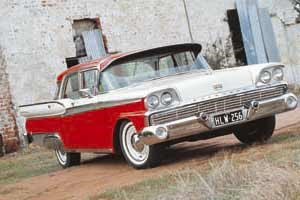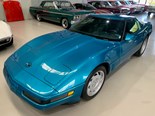Ford Fairlane: Buyer's guide
In 1959 there was nothing finer than a Ford Fairlane if you wanted to flaunt your success.

|
|
Buyer's Guide: Ford Failane
|
Ford Fairlane
Ask anyone today which cars best signify success and the answer you'll probably get is Mercedes-Benz or BMW. It is unlikely that anyone will put forward the Ford Fairlane, but in 1959 it was a very different story.
When the Fairlane hit our roads in 1959, replacing the popular Customline, those now prestigious German marques were virtually non-existent in Australia. Back then both companies were still recovering from the ravages of World War 2, it would be years before they would become the status symbols they are now, and the big Ford was the undisputed king of the road.
For successful businessmen or farmers enjoying the fruits of a bumper wool clip or wheat harvest there was nothing finer than the Fairlane.
The Fairlane badge first appeared in America in 1955, but it wasn't until 1959 that it arrived here. The '59, or 'Tank' as it quickly became known, was virtually identical to the American Fairlane, although it was supplied through Ford of Canada.
Ford offered three models, the rather spartan Custom 300, the more luxurious Fairlane 500, and the Ranch Wagon station wagon.
All came in component form; they were already right-hand drive, and only required assembling. Some local parts were fitted in the process to increase local content, these being larger 15-inch wheels and tyres - the American cars had 14-inch wheels but concerns about ground clearance in rural areas where many of the cars would be sold, convinced Ford to fit the larger wheels - glass, seats and interior trim.
The first cars were assembled at Ford's Geelong factory, but assembly was moved to the new Broadmeadows plant when that opened later in 1959. The first car to leave the Broadmeadows assembly line was, in fact, a Fairlane 500.
All models had the powerful punch of a 332 cu. in (5.4-litre) Thunderbird OHV V8 engine; there was the choice of a three-speed column-shift manual gearbox or two-speed Fordomatic auto trans, and the rear-end was the indestructible nine-inch diff.
The front suspension was independent by upper and lower wishbones, with coil springs and telescopic shock absorbers, while the rear was a live-axle arrangement with leaf springs and telescopic shock absorbers.
Steering was worm-and-peg without power assistance, while braking was by large drums all round.
Inside there was vinyl and fabric trim, and plenty of accommodation for six or more adults with broad bench seats front and back. There was also plenty of capacity for their luggage in the cavernous boot.
Safety was a consideration even back then, with the deep-dished steering wheel to prevent your head hitting the steering wheel hub, and the switches were located behind the wheel so you wouldn't crack you skull on them in the event of an accident.
Although it was replaced with an all-new new model in America after a single year in production, the Fairlane continued here, with minor changes, until early in 1962 when it was replaced by the 'Compact' model.
The so-called 'star' grille was replaced by the 'mouth organ' grille from the Canadian Ford Meteor in 1960, and this was retained right through to the end.
The 1960 model also saw the Fairlane name appear on the chrome strip across the leading edge of the bonnet, a Ford badge replaced the lettering on the face of the bonnet, and circled stars replaced the brass decorations on top of the front guards.
Stainless trim strips were also added along the lower line of the fins on the rear doors and guards.
Electric windshield wipers eventually replaced the vacuum wipers, but still there was no heater or demister as standard, and a radio was an optional extra.
Mechanically there was little change between 1959 and 1962, with the exception of the engine which was uprated in 1960 when the compression ratio was raised in line with improved fuel quality, and the output climbed to 168kW as a result.
ON THE ROAD
Road testers of the day raved about the new Fairlane, praising all aspects of its on-road performance; steering, braking, ride and even its handling.
Despite being more than five metres long and weighing almost 1700kg, the early 152kW V8 would propel the Fairlane from rest to 100km/h in 12.1s; the standing 400 metre sprint would be dismissed in 19s, and it would reach a top speed of 173km/h.
Even today the big Fairlane is surprisingly nimble, with good acceleration and a fine turn of speed on the highway. It will happily lope along at 100-plus km/h.
The ride is firm but comfortable, quite surprising for a car essentially derived from America, and the handling is reassuring.
We didn't get a chance to test the big drum brakes, but contemporary road testers were impressed with the Fairlane's ability to stop without grabbing or fading.
Some later cars were fitted with a PBR brake booster which enhanced the Fairlane's braking performance, and most of those that weren't fitted with the booster at the factory have now been been fitted with them by owners wanting better brakes in today's traffic.
OWNER'S VIEW
Max Pethybridge searched the length and breadth of the country for a 'Tank' Fairlane before he stumbled on an original two-owner 96,000-mile '61 Fairlane 500 in his home town of Shepparton.
It had seen little use in the previous 18 years, but was complete and running, and while it had some rust, according to Pethybridge, it wasn't severe.
Pethybridge bought the Fairlane in January 1997, and immediately began stripping it for restoration, which he completed in March 1998.
While he's kept it original, Pethybridge has added some original accessories, like a brake booster, sun visor, rear venetian, stainless rear skirts and wheel spats.
Born in the early 1940s, Pethybridge was a teenager about to hit the road for the first time when Ford released the 'Tank' Fairlane.
"It was so big and so imposing," said Pethybridge. "It was the car farmers bought after a good year."
"They were like nothing else on the road back then. The styling was the latest to come from America when the FB Holden was only just getting fins, and it had lots of chrome which I loved.
"It's like sitting in an armchair," he says. "They are so smooth that it's very easy for the speed to climb without you being aware of it."
Unique Cars magazine Value Guides
Sell your car for free right here
Get your monthly fix of news, reviews and stories on the greatest cars and minds in the automotive world.
Subscribe

.jpg)











.png)

